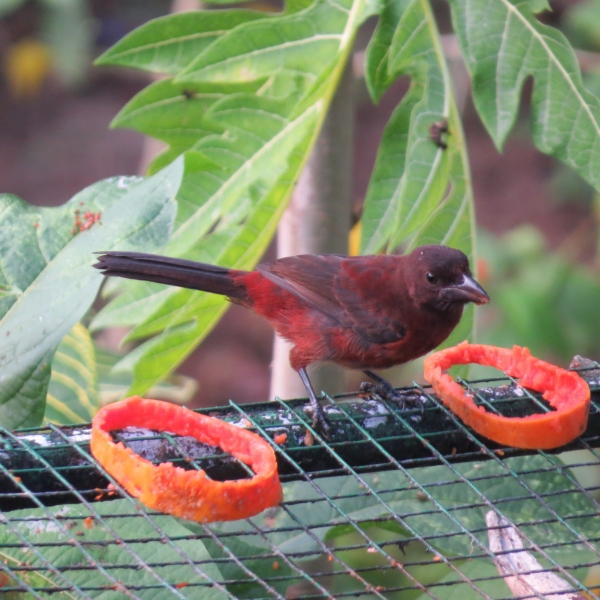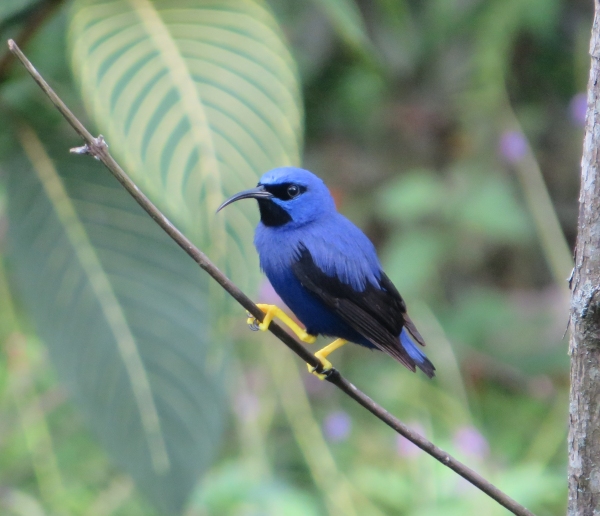The Asa Wright Nature Centre (AWNC) is a “Not-for-Profit” Trust established in 1967 by a group of naturalists and bird-watchers to “protect part of the Arima Valley in a natural state and to create a conservation and study area for the protection of wildlife and for the enjoyment of all.” It is the oldest nature center in the West Indies. Comprising nearly 1,500 acres of mainly forested land in the Arima and Aripo Valleys of the Northern Range, the Centre’s main facilities are located on a former cocoa-coffee-citrus plantation, previously known as the Spring Hill Estate. This estate is surrounded by tropical rainforest with a lush forest canopy. The center offers lodging and we were heading inland east to spend a night there.
It's not in our nature to just go and not find out all the other things to see along the way. Lin's Rough Guide to Trinidad and Tobago came in very handy. For instance, as we passed what we thought was a lighthouse on the highway in the middle of Port of Spain, we read that it was, indeed, a lighthouse in the center of Port of Spain, quite far from any water. It appears the Port of Spain Lighthouse, an hexagonal tower, was built in the 1880s. When the shoreline was extended, the St. Vincent Jetty upon which the lighthouse was originally built was demolished and the lighthouse ended up in the city center. As a navigational aid, the original purpose of the light was lost. At some point (perhaps in the 1980s?) some restoration work was done on the tower, but by 2004 it was in poor condition, with a lean of about 5° which remains to this day. It gets painted different colors every so often to commemorate sports events or holidays. Today it's white. The leaning tower of Port of Spain?

We traveled through St. Joseph, the oldest town in T & T. Founded in 1592, it was originally named San José de Oruña and served as the capital of Spanish Trinidad until 1783. We passed by the beautiful Mohammed Ali Jinnah Mosque in search of Trinidad's oldest church, St. Joseph's. It was easy enough to find, just up historic Abercromby Street.

In actuality, we weren't really looking for the church as much as the old graveyard in its backyard. A closed gate in front of the church barred all access. We weren't sure how to get in until a lovely lady, Marie-Michele, caught our attention. She had just come from the churchyard and we asked her how to get in. She told us the church was in rough condition (very evident as we drew closer) and was undergoing renovations. The graveyard, however, was accessible and she showed us the way. A lovely creche was on display in the church's side yard.

In addition to several centuries' old Spanish, French and British tombstones, there was one in particular for which we were searching. An unknown pirate was supposedly buried here, dating from 1682, a skull and crossbones carved on the headstone. Marie-Michele had never heard of it. She asked a worker. No idea. We searched and searched and found nothing. Just as we were leaving, I spotted the tombstone … hidden in plain sight. It was a large monument … larger than all the rest … and clearly displayed the skull and crossbones, plus the original carved date in marble. Pretty pleased with our find, we bid adieu to Marie-Michele who extended an invitation for tea at her house. Wow!


We returned to Eastern Main Road and headed further inland. The next stop, Lopinot, was further off the beaten track, but considered an historic site and we decided it was worth the trip up into the foothills of the Northern Range. Again, a serpentine, narrow road and Lin and I were grateful that David was driving and we weren't.
Named after the respected and well-loved Compte de Loppinot, the former plantation, La Reconnaissance, was a cocoa estate. After Loppinot died, the estate was abandoned. In the 1970s, the T&T Tourist Board took over the property, restored it and it now serves as an historical site, park and small museum. We crossed over a rather decrepit bridge to see the plantation house.

The plantation house is lovely and we could understand why the Compte chose this area for his plantation.

The house contains some small memorabilia from the plantation era including some of the original furniture and parang instruments. Have a listen to some parang music here.

We wandered through the grounds until Kevon found us and guided us along with lots of historical and local information. We passed by long drying sheds and wandered easily in the shade of giant samaan trees. He took us to the family graveyard, which like others we'd seen, was grown over and uncared for. He asserted that the reason for the unkempt graveyards had much to do with local superstition and fear of the burial grounds. It's said that on full moon, stormy nights, the Compte rides a white horse around the grounds. Ghosthunters International has even done a segment on the legend.

Back to the Eastern Main Road, we headed to Arima and found the unmarked cut-off road which led up, up, up once again to Asa Wright Nature Centre, our destination for the next day or two. After negotiating still another circuitous, unmaintained, potholed, steep narrow road, we all sighed in relief as we saw the entrance sign for Asa Wright.
Check back tomorrow. Asa Wright Nature Centre is a magical place.































